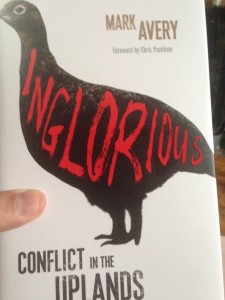 It would, perhaps, be a bit surprising if the guys at Raptor Persecution Scotland weren’t keen on Inglorious – but stranger things have happened. And so I was relieved that they seemed to love it!
It would, perhaps, be a bit surprising if the guys at Raptor Persecution Scotland weren’t keen on Inglorious – but stranger things have happened. And so I was relieved that they seemed to love it!
Inglorious is not a book about raptors – it’s a book about the ills of driven grouse shooting. But there is quite a bit about raptors and raptor persecution in the book. However, the end to driven grouse shooting will be brought about by a variety of methods and for a variety of reasons. Unsustainable land use will be as important as wildlife crime in bringing an end to driven grouse shooting.
I won’t publish a blog each time Inglorious gets a good review – and certainly not when it gets a bad one – but what with this review and the one by Rare Bird Alert, Inglorious has got off to a good start with audiences that matter to me.
[registration_form]
I shall encourage my local independent (and very nature-friendly) bookshop to stock some copies.
Does it have any Ralph Steadman hen harrier and gunshot illustrations like this one? http://www.theguardian.com/books/gallery/2015/jul/15/ralph-steadmans-portraits-birds-extinction-nextinction-in-pictures
No harm in as well as buying your own copy to ask the local library service if they can stock it for benefit of their ‘customers’. Important and very relevant book so think there’s a strong case for making it available, especially in areas adjoining driven grouse moors?
Mark, I enjoyed this passionate book and offer some constructive criticism, which you might wish to counter in the second edition. On page 20, you say “let me just establish that the Hen Harrier is unpopular for the simple reason that … it dares to take small Red Grouse …”. This is a bit misleading. On the same page, you admit that they also take adult grouse – a seeming contradiction that appears clumsy rather than disingenuous. Much more importantly, you omit to say that one of the main beefs that keepers have against harriers (and eagles) is that they can wreck grouse drives by themselves driving birds away from the guns (shooters). This is done in plain sight of the guns and the keepers take much of the blame. It is one of the main reasons that the numerous attempts to reach a solution to this conflict (eg licences to kill some but not all harriers and eagles) have failed. By not mentioning this aspect, you open yourself to the criticism that you do not fully understand what it is that you are attacking.
Personally, I agree that the hunting ethos much is more acceptable than the shooting one and could wish that grouse hunting fully replaces grouse shooting. As hunting requires much more knowledge than shooting, it can also be much more satisfactory.
Robert – Welcome to this blog! I’m glad you liked the book, given that you are an expert on grouse biology.
Your second point is well made – I’m not sure I do mention the disturbance aspect very much. Of course, post-Langholm 1, it tended to fade into the background a bit when we all accepted that unmolested bird of prey populations were pretty good at hoovering up Red Grouse so that the large bags necessary for driven grouse shooting are difficult to achieve. Fair point (although, I think, quite a minor fair point).
Your first point is slightly odd, if I don’t sound too defensive in saying so, in that on page 20 I say (not admit), twice, that Hen Harriers take adult Red Grouse – as they clearly do (and in the past maybe adult chickens too – same page). The whole of Chapter 3 is given over to a more detailed summary of the impact of Hen Harriers (and Peregrines) on Red Grouse bags and populations.
But I am glad you enjoyed Inglorious.
Thanks for the kindly welcome, Mark. Some clarification seems to be in order. As I read it, the phrase “… the simple reason that …” conveyed the meaning “… the sole reason that…”. You obviously didn’t mean this but may wish to amend the phrase in future editions.
My experience with grouse keepers is more past than current. Even so, many of them have told me that they are more concerned with the disturbance that harriers cause to drives (and hence to keepers’ remuneration) than with the chicks that the birds kill. If so, it doesn’t matter how effective diversionary feeding and other ploys to reduce to reduce the chick toll may be – harriers will still be seen as a pest.
Before Langholm1 there was de facto harrier rationing on some grouse moors. Keepers might leave a couple of pairs to satisfy birders but kill what they regarded as an excess e.g. by leaving a gin trap set on the nest. Post Langholm, there was a move to formalise this approach (though not the use of gin traps!) by introducing licensed culling of excess harriers, but it didn’t have a chance in the confrontational atmosphere engendered by differing interpretations of the Langholm results.
Robert – thanks.
That latter approach would have been subject to legal challenge of course as it would have been seen as being somewhat confrontational itself.
Agreed. Many people nonetheless spent (wasted) much time discussing it, thus continuing to kick the battered old can down the road.